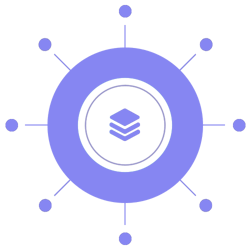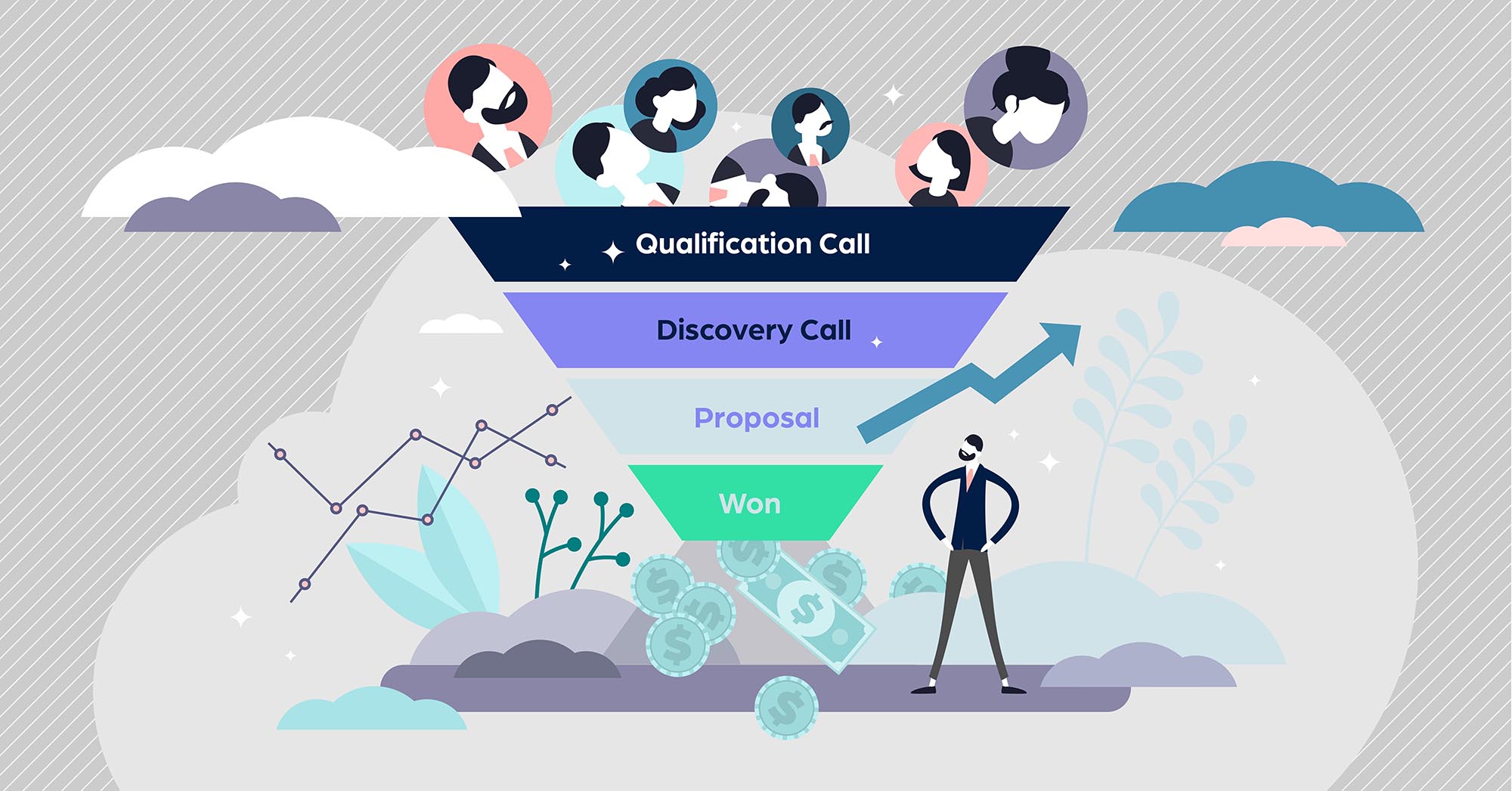Ready to Make a Change?
We Work With Highly Motivated agencies who are looking for the tactics they need to scale.
When you first got into the agency business, did you picture a larger bank account, shorter workdays, and more free time?
Or have you let imposter syndrome keep you from reaching your full potential?
When looking for new clients, have you ever thought to yourself:
“This was the last prospect in the pipeline. I can’t afford for them to say no.”
“ Even if this client DOES sign, I have no idea where I’m going to find the labor hours. My team is swamped.”
“I feel like I’m working harder, but making less.”
Is this how you envisioned your experience as an agency owner?
By the end of this article, you’ll be equipped with the toolkit you need to grow the successful business you’ve always envisioned for yourself, and start reaping the benefits of being a successful business owner.

More often than not, agency owners find themselves in the vicious feast and famine cycle.
You can have the best creative team churning out the best content in the industry, but working with a traditional agency mindset will roadblock you from ever seeing the growth you deserve. It’s time to modernize!
So, how can you tell if your business model is costing you $$ (and sanity)?
You can’t get ahead of your operating expenses and can only seem to break even.
It’s difficult to forecast revenue projections outside of 30-60 days because all of your contracts are currently project-based.
You can’t seem to scale your profits, even when you take on additional clients.
Your workload has started to monopolize your time and negatively affect your personal life.
Your agency’s financial positioning is so fragile just one misstep would wipe out your savings account.
You spend so much time on client work, you don’t have any time left to focus on business growth.
Your agency has been overrun by your clients, and you feel out of control of your own business.
If even one of the above resonated with you, you are overdue for a structural overhaul. The good news though, is that newfound freedom and growth within your business can be just around the corner.
If you’re willing and motivated to make a change, you’ll feel the stress of operating in project-to-project survival mode melt away and your creative enthusiasm will be reignited.
You need to get back to basics and reevaluate your business and pricing models, sales process, and target market to determine how you can achieve scalable success.
Quick Reference Links
You researched and created a killer proposal for your client. You nailed the pitch, and they’re excited to sign on. All the hard work is over, right?
Wrong.
The success of your agency and the satisfaction of your clients will never be a fluke. It’s the result of a combination of strategic, intentional decisions that you make, long before the client signs on the dotted line.
Before you spend your first dollar in your agency, it’s important to remember the why so that you can grow.
Why will businesses want to seek out your service in the first place? Keeping your vision focused on providing the solutions to their problems (not just fancy ad campaigns) will lead to the clients you want to have seeking out your services.
Remember to put yourself in the mind of your prospective customers when you are determining your agency’s strategy:
When a business owner approaches a marketing agency, chances are they’ve been sitting on their problem for a while. Remember, the better you get at understanding the root cause of their problems (and generating the solutions to solve them), the more successful your agency will become.
Now that you have a better idea about the basic needs your prospective customers have, it’s time to get a little more specific.
Out of the millions of businesses out there, how can you pick the RIGHT ones to work with?
“Shiny object syndrome” is a common trap, especially for new agency owners.
When you are eager to fill your roster with clients, it’s tempting to want to say “yes” to everyone.
But as backward as it may seem, the more you say “yes,” the more you are actually limiting your earning potential.
So why would you want to turn down a client willing to generate your agency revenue?
While it may seem counterintuitive, you will attract bigger and better quality clients by niching (or specializing) your service offering. Taking the time to analyze your skillset, align your work with your passion, and specialize your services will expedite your road to profitability.
When you provide a niche (vs. generalist) service, you are selling expert knowledge and effective problem-solving solutions to your prospects. Instead of having to take a “winging it” attitude across wildly different types of clients that will come through your door, you will have:
An in-depth understanding of the specific target market you are consistently working with. This is essential to creating the killer content your clients love to see.
To see profitability from dollar ONE, you need to implement a scalable process from day ONE as well. The successful phase of your agency business starts now.
Don’t worry if the idea of choosing a niche is daunting. Even if it feels impossible now, your future self will be thanking you.
Take the time to really think your options through, and evaluate how you want to move forward:
Once you are in the groove and build up your library of case studies and client wins, you will naturally become more enthusiastic and knowledgeable about your niche when speaking to potential clients. The more focused your efforts become, the more your unique expertise inevitably grows.
Who wouldn’t want to work with someone like you?
A word to the wise, however: While your niche never has to be set in stone, it takes time to get anything off the ground, including a client base. Give yourself an honest amount of time (no less than two months) of putting the work in before making the decision to change things up.
Everyone has something unique to offer the world, so don’t be shy to spotlight yours! Determine what specific skillset you are going to offer prospective clients to set yourself apart from the competition.
Use everything you’ve gained throughout your career so far to demonstrate your own credibility!
Really get inside the heads of the business owners you want to target. What are they most passionate about? What irritates them beyond belief? Let the language of your customer guide how you speak to them.
Your probability of becoming profitable is only as high as your ability to interpret your target market’s problems, so really take the time to get to know them.
Whether it’s media appearances, signing high-profile clients, or having earned unique educational credentials, demonstrating credibility and social proof is an essential component in earning a client’s trust and respect. Without it, prepare for a rocky sales process.
Highlight your credibility in your own marketing assets, throughout your sales process, and through referrals to build trust within all of your client relationships.
A disorganized business will always be on a slippery slope in the wrong direction. To keep the needle moving in the right direction, your data and internal processes need to be accessible and easy to interpret. This can include:
In the next section, we are going to uncover the most important element to your success: strategizing how you will be getting paid. By prioritizing scalability when choosing your pricing model, your agency will grow at record speed.
We believe that purpose-driven agencies are the most successful and impactful. Many businesses can have revenue and profit, but without purpose, they will not survive the test of time.
We believe in looking inward at yourself and your organization, defining your purpose and mission before defining your marketing strategy.
Purpose Driven Agencies are where it's at!
When you have energy, you have momentum. When you lack energy, it can feel like pushing your agency uphill.
As a core principle of the way that we work with clients, we always consider the energy of the owner of the agency. Their energy is the driver of the organization and its future growth.
When you have energy you have momentum, when you have momentum growth is inevitable.
You must be an expert in your field; without this, you cannot have an attractive offer. We do not create expertise; we help agencies yell it from the mountaintop.
Expertise is created through focus and dedication. With a greater focus on your purpose and superpower, you are able to have a greater impact on your clients and thus experience greater growth for your agency.
Be the expert that your clients would dream to work with.
Authority is the personification of your expertise. That experience that you have gained over the many years of honing your craft can help so many people.
That wealth of knowledge should be shared openly with the public and touch many lives. When you are willingly sharing your superpower with the world, you will attract your soulmate clients that you were destined to work with. Share openly and often.
"Do well by doing good."
Scalable agencies are founded on recurring revenue. They are able to have deeper relationships with clients, and less distraction caused by the need to replace revenue.
This model is more scaleable, predictable and profitable for agencies. It encourages truly mutually-beneficial relationships with clients; the client wins, and your agency wins.
If you do not have a foundation of recurring revenue, you should look to make the switch today.
Seamless operations are key to a results-focused agency. Processes are what allow for repeatable results for clients and the agency.
You should have a "your way" system that allows for each client, each project to have sustainable and repeatable results. Allowing each team member to be operating in the same way, communicating flawlessly so that each client has the same rock-star experience working with your agency.
When you are specialized in the services that you offer, you are more readily able to attract your ideal client because you are better equipped to discuss how and why your services will help them accomplish their goals.
This specialization creates buyers' safety with clients and assurance of the outcome. Being a "jack of all trades" makes you a generalist, being focused makes you specialized.
The vast majority of agencies are looking outward for their positioning. This has resulted in the industry all sounding the same. If you were to take the logo and name off of 10 agency websites, would you be able to tell the difference between them? Unfortunately not.
We believe in doing the hard work here, looking inward rather than looking outward for your differentiator.
Authenticity is magnetic, tell your story, share your why and you will attract the clients that you are meant to work with.

We believe that purpose-driven agencies are the most successful and impactful. Many businesses can have revenue and profit, but without purpose, they will not survive the test of time.
We believe in looking inward at yourself and your organization, defining your purpose and mission before defining your marketing strategy.
Purpose Driven Agencies are where it's at!
When you have energy, you have momentum. When you lack energy, it can feel like pushing your agency uphill.
As a core principle of the way that we work with clients, we always consider the energy of the owner of the agency. Their energy is the driver of the organization and its future growth.
When you have energy you have momentum, when you have momentum growth is inevitable.
You must be an expert in your field; without this, you cannot have an attractive offer. We do not create expertise; we help agencies yell it from the mountaintop.
Expertise is created through focus and dedication. With a greater focus on your purpose and superpower, you are able to have a greater impact on your clients and thus experience greater growth for your agency.
Be the expert that your clients would dream to work with.
Authority is the personification of your expertise. That experience that you have gained over the many years of honing your craft can help so many people.
That wealth of knowledge should be shared openly with the public and touch many lives. When you are willingly sharing your superpower with the world, you will attract your soulmate clients that you were destined to work with. Share openly and often.
"Do well by doing good."
Scalable agencies are founded on recurring revenue. They are able to have deeper relationships with clients, and less distraction caused by the need to replace revenue.
This model is more scaleable, predictable and profitable for agencies. It encourages truly mutually-beneficial relationships with clients; the client wins, and your agency wins.
If you do not have a foundation of recurring revenue, you should look to make the switch today.
Seamless operations are key to a results-focused agency. Processes are what allow for repeatable results for clients and the agency.
You should have a "your way" system that allows for each client, each project to have sustainable and repeatable results. Allowing each team member to be operating in the same way, communicating flawlessly so that each client has the same rock-star experience working with your agency.
When you are specialized in the services that you offer, you are more readily able to attract your ideal client because you are better equipped to discuss how and why your services will help them accomplish their goals.
This specialization creates buyers' safety with clients and assurance of the outcome. Being a "jack of all trades" makes you a generalist, being focused makes you specialized.
The vast majority of agencies are looking outward for their positioning. This has resulted in the industry all sounding the same. If you were to take the logo and name off of 10 agency websites, would you be able to tell the difference between them? Unfortunately not.
We believe in doing the hard work here, looking inward rather than looking outward for your differentiator.
Authenticity is magnetic, tell your story, share your why and you will attract the clients that you are meant to work with.
So you’ve picked a lucrative niche, have an impeccable reputation, and referrals are flowing in. That’s all you need to achieve scalable success, right?
Not quite.
The most important piece of the profitability puzzle is determining your agency fee structure. To do this, you need to choose the best marketing or creative agency pricing model for your business. Don’t allow yourself to get swept up in the worries of “what should agencies like mine charge?” You don’t need a full digital agency price list to decide what is best for your business. Instead, evaluate what will help you stand apart from your competition.
Your business is 100% unique, so you should be approaching your agency’s pricing with the same mindset. The expertise and creative process your niche offers should be the primary factors when choosing your pricing model.
Imagine you saved up a year’s worth of salary to buy and import a new, foreign specialty car. Thousands of hours and months of waiting have built up the anticipation of this big purchase. After a few months of driving, it comes time to schedule its first service.
Considering how much you value your new car, do you make an appointment at the cheapest mechanic you can find? Or do you seek out the only mechanic in the city who has experience working with your beloved car (even though it’s almost double the price).
The same buying thought process applies to seeking out a marketing agency. Businesses who are serious about seeing the return on their marketing investment shouldn’t be seeking generalist agencies for their projects. This will result in frustrating longer timelines, who are costing them more in the long run. Cheaper always costs more.
No matter if you are a branding agency, digital marketing agency, SEO agency, PR Agency, Social Media, or Video Production Studio, which criteria should you use to decide your agency fee structure?
Historically the most popular of them all, the hourly model works exactly as it sounds: the client is billed for the total amount of hours logged for the project.

This model is a typical go-to when outsourcing talent for a job, or newer agencies just getting started. It is the easiest to understand and keep track of from a billing perspective.
This model can be an attractive alternative because:
However, running an agency doesn’t just include client work…
The hourly pricing model typically doesn’t account for required administrative hours or business development. As your client base grows so will the amount of talent you’ll have to bring on (and pay for!!). More heads = more risk and eventually, agencies relying on this agency pricing strategy will reach a profit plateau and have a difficult time climbing out of it until they restructure their pricing model.
As a general rule, the emphasis of a project proposal should stay focused on the value the client will receive from the end result. Not the time it took to get there. This model is typically found when outsourcing content creation-type roles.
While the hourly pricing model may seem like the fastest (and easiest) way to ramp up operations, this mode will quickly lead to profit burnout. Avoid solely relying on this model if you can.
Agencies that are further along in their journey will likely have developed a better understanding of their niche, clear deliverables for the offer, and general time investment required for each service offering. Using a fixed fee model simply means they are charging a fixed price for a fixed deliverable (regardless of the amount of time or resources it takes to complete).
A fixed-rate fee should be considered because:
But what if the project runs into delays, or ends up requiring extra resources? When working with a fixed rate, additional costs, unfortunately, will eat into bottom-line profits. Clients may also be apprehensive of this pricing model, given they don’t have as thorough of control.
Branding, content creation, SEO, and social media agencies will typically utilize this pricing model (or variations of it).
A fixed fee pricing model will enable more business growth potential compared to the hourly model but will require clear communication of the deliverable breakdown to clients when proposing this type of contract. Be prepared to be transparent!
Only seasoned agencies should consider using the performance-based pricing model, as the money only comes from the results. You need to be confident in what you know you can deliver before proposing this type of contract to a client, as you as the agency are assuming most of the risk.
Performance-based models are typically paid out on an “as per” basis on some sort of performance measurement metric the client uses (eg. per click). Commission-based models are based on total sales or the ultimate success of the project.
This model can be an attractive alternative when:
But what if the project bombs? You’ll need to have a financial safety net ready if you’re presenting this pricing model to a client. If they don’t get the results they want, you better be prepared to take the hit.
This model is the most work-intensive of them all but has the potential to yield highly profitable results when working with more developed clients. The larger the campaign, the more potential profit there is to be made, so only tenured agencies should be considering this model. This model enables both the agency and the client to scale synchronously.
If the current goal of the agency is to promote long-term customer retention and scale business development, then a value-based pricing model should be considered. This marketing agency pricing model is primarily oriented around the competitiveness of the niche, the current monetary value of their offer, and the estimated time investment required. The more accurate the predictive data you use, the larger the potential return.
Similar to the performance-based pricing model, this structure largely benefits tenured agencies:
But remember…
You’ll need a proven track record of high-ticket marketing wins before pursuing this model. You’ll need to identify and quantify the client’s unique definition of “value” from the start. Otherwise, a lack of clarity can quickly lead to lost opportunities.
Nothing is more stressful than not knowing how you are going to make payroll next month.
Expecting your agency to survive on a project-to-project basis is anxiety-inducing and unnecessary, but unfortunately far too common in the industry.
Imagine how calm and predictable forecasting monthly revenue 60-90 days in advance would feel.
You’d never have to dip into the savings fund or accept low-barrel clients again…
These are all of the benefits of using a retainer (or monthly recurring revenue) based pricing model.
The goal of this model is to have the client commit to retaining the services of the agency for a recurring number of months.
The key to presenting this agency pricing model, is Instead of focusing on the amount of time it takes to complete the project, highlight the value the client will receive instead.
By planning project touchpoints and payments in monthly milestones, you will:
In general, a value-based, retainer model is the most recommended marketing agency pricing package. Using this model ensures that every stakeholder on the project wins (including your bank account).
Not quite sure how to transition your pricing structure to resemble a value-based retainer model?
Start with strategic steps towards your goal. Set your foundation with a fixed-price model. This will allow you to observe over time where your delivery timelines and overhead costs usually fall. As you gain expertise and optimize your processes, you can pivot into a more profitable retainer model.
Now that you’ve committed to your pricing model, it’s time to set the price tag. This is a crucial step in the process, as it is a key factor in establishing profitability and growth.
When you go into a retail store to browse and eventually make a purchase, do you buy the first thing you see?
Or do you like to browse, compare, and take some time to think before you seal the deal?
The same goes for your prospective clients.
If you haven’t already, it’s time to strategize how to productize your service. If you’re not presenting your offer as a tangible solution to your client’s problems, you may be missing out on some seriously low-hanging fruit.
So if getting a client to sign a retainer agreement is the ultimate goal, how do you structure your client proposals to ensure you seal the deal?
What you REALLY need to be asking is, “how can I sell MY unique creative process in such a way that clients would be crazy NOT to sign with me?”
Imagine you’ve been feeling sick, so you pay a visit to your doctor. Now, you wouldn’t up expecting to tell the medical expert what prescription to write for you. You’ve sought out their expert counsel because you can’t solve the problem alone.

Communicating with a new prospect is no different. They are coming to you to receive the marketing expertise they would not have had otherwise. Chances are, they’ll be looking for:
But if you expect them to hand over the cash, they deserve to fully understand what it is they’re paying for.
The good news? You don’t really have to restructure much (other than a bit of copy) in order to communicate your offer in this optimal way. By presenting your offer as a variety of specific, itemized service offerings, you can communicate what’s possible to the client, while still giving them the freedom to choose the option that works best for them.
When you structure your offer in this way, you are selling your expert problem-solving system. Don’t forget - you are the expert. It is your job as the agency owner to guide prospective clients to the offer that works best for them.
The tried and true service productization presentation model follows a simple A-B-C presentation:
Your clients need to feel comfortable and safe in their professional relationship with you. By providing transparency into your successful system, you will cultivate a positive co-working environment, and increase your likelihood of securing them in a retainer-based pricing model.
Don’t forget that a proposal conversation is a two-way street. As much as you’re determining whether a prospect meets your qualifying criteria, they are also gauging if they want to work with you. If your agency’s processes are disorganized and hard to follow, prospective clients will quickly become turned off and take their business to another agency they feel they can trust.
Remember, confusion can easily escalate to mistrust.
Once you have your freshly designed good, better, and best packages in place, it’s time to take your sales process for a test drive!
Once you have a prospective client interested in your offer, it’s time to execute your proposal and seal the deal.
When you meet with any new prospect, you should be following the same process:

Even if you follow an airtight call script, no two pitches will ever be the same. To ensure a successful pitch (no matter what kind of business owner you’re speaking with), remember these crucial points:
Getting your new client to sign on the dotted line is half the battle, but a project is never complete until the money hits your account.
It is imperative that you select a billing cycle that aligns with the pricing model and service offering you are selling. Otherwise, your agency will quickly become susceptible to cash flow problems, and run into unnecessary roadblocks while completing projects for clients to deadline.
No matter what billing cycle you choose, the #1 goal is to keep revenue flowing into your agency on a monthly basis as frequently as possible.
Frequently used billing cycles include:
Similarly to the rationale of sticking to a retainer-based pricing model, you should aim to bill your clients on a monthly basis (regardless of project milestone status).
This will promote accurate financial forecasting and revenue reporting accuracy, and promote better overall liquidy in the business. This also benefits the client, as it promotes better feedback processes, and ensures they are satisfied with the investment by the time the end result is produced.
If the project is set to incur any additional fees (such as media buying-related costs for example), they should be charged upfront, before work begins.
Hearing the word “no” in our business can be a real source of anxiety for many agency owners, so much so that many avoid prospecting new clients altogether. But as we’ve learned before, our ability to say “no” is actually a valuable source of power for the success of your business..
Performing cold outreach for example, will always yield more “no’s” than “yes’s.” You’re reaching out to businesses without fully knowing if they’re even interested (or have the budget) in your services. In fact, it’s actually quite unlikely that a recipient of cold outreach will purchase your services from their first interaction with you alone. While some will eventually remember you when they DO need your services, there are many leads you will reach out to that will never buy (and if you’re lucky, you find out early).
Remember, every no you receive is pushing you towards a more fulfilling yes. Currently, 80% of agency owners are falling short in their prospecting efforts. Remember, the money is in the follow-up!
If you go the extra mile to secure that top 20% spot, you’ll quickly get ahead of the game.
Before you start your first round of prospecting outreach, assess your current sales process:

Understanding the current state of affairs will help you optimize your sales process, drive better success to your pricing model, and ultimately improve your conversion rate.
Ready to meet your new clients?
Your goal should be to standardize your sales process in such a way that prospect has the same experience when communicating with your agency. This means your process should be efficient enough to address every qualified prospect that comes through the door. It’s your opportunity to set the stage for a successful client relationship and demonstrate value, consistency and trust to your clients. If you succeed, they will be thanking you for being the solution to their problems before you know it.
How can you ensure your process remains consistent?
When you’re NOT investing time into lead generation efforts, you’re not enabling your agency to attract clients that support your growth. With an empty pipeline, you’ll quickly feel like you’re losing control of your boundaries and your clients will start running YOUR show before long.
Now that you’ve fully committed to your niche, restructured your pricing model, and reevaluated who you're targeting, your pipeline is full of higher-paying projects.
But what about your original clients who have been loyal since the beginning?
You’ve been avoiding raising your rates on them, but it is starting to make less and less financial sense to keep them on your roster. After all, you’ve got your newly cultivated lineup of higher-quality work.
While some clients may eventually get priced out of your services (and that’s okay!), there IS a way to break a price increase to them gently and walk away with a renewed, bigger contract.
Since you originally signed this client have you…
These are just a few examples of the types of rationale you can present to clients who give you pushback but follow what is organic to you and your business.
The good news is, is that some clients will not be able to afford to continue your new rates. This simply replenishes your bandwidth for clients who are not priced out of your new rate, meaning you’re grossing the same amount (if not more), but working less.
A profitable agency doesn’t happen by chance. It’s a result of data-driven decision making.
The only thing that truly determines your success is the numbers, so you need to know them like the back of your hand. Guesswork belongs nowhere near your balance sheet.
By getting into the habit of regularly reviewing your performance metrics and communicating action items to your team, you’ll be amazed how quickly performance can turn around.
Client and market data, sales data, and productivity data are just a few examples of the types of numbers you need to be consistently monitoring to drive success within your agency. By developing routine reporting and data analysis processes, you will be able to stay one step ahead of your balance sheet.
There are 3 main reports you should be generating on a weekly basis. Get into the habit of reviewing them with fellow leadership, so no one has any surprises.
Make sure you make the most of the softwares you are paying for. Time trackers, project management software, and CRM platforms all contain valuable data that can be exported to aid in decision-making.
Growth will never come from comfort. Every project your agency sees to completion presents a new opportunity for growth, improvement, and change. It’s important to review every finished campaign (successful or not), to determine areas of opportunity to action for the next time.
The final outcome does not solely fall on one specific team or individual. It takes the entire agency to see a project to completion (billable or not), so all stakeholders should participate in the review. This should include (if possible):
To better structure the conversation, implement a closing checklist to guide your post-mortem reflections, and identify process gaps that need to be addressed:
An agency that diligently follows a project close-out process is guaranteed to have better cross-functional communication, higher customer satisfaction rates, and will see their bandwidth expand faster.
Picture this:
You just wrapped up your weekly team meeting before you head out for a (disconnected) long weekend. You were blown away by the sales team this week - they’ve tripled booked discovery calls compared to last month. For the first time in months, you’re leaving at the end of the day on time, and with no outstanding client tasks. You even got to the gym this week. Life is good.
You now have the blueprint to make this your reality. You have the power to make the changes you want to see in your life, and in your business.
So what can you do to start seeing improvements NOW?
All it takes is 90 days and a few small changes to tip the scale in your digital marketing agency.
If you stay focused on your ultimate goal: helping business owners to yield success, your own will naturally follow.
We Work With Highly Motivated agencies who are looking for the tactics they need to scale.